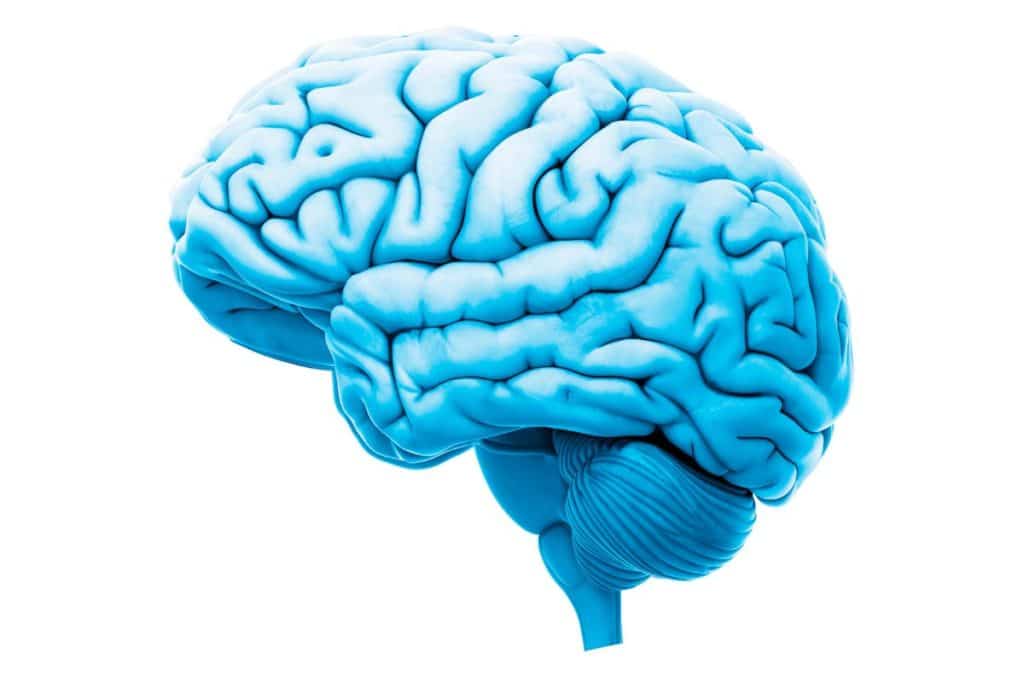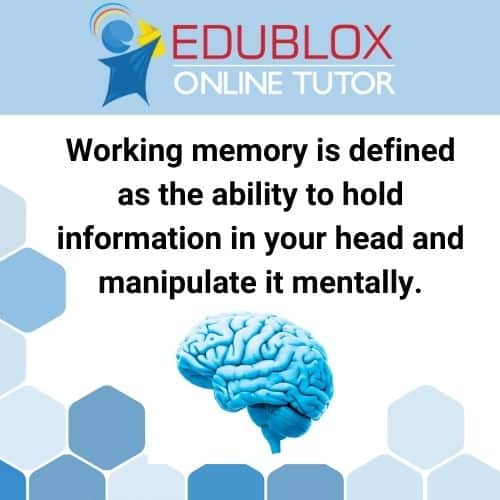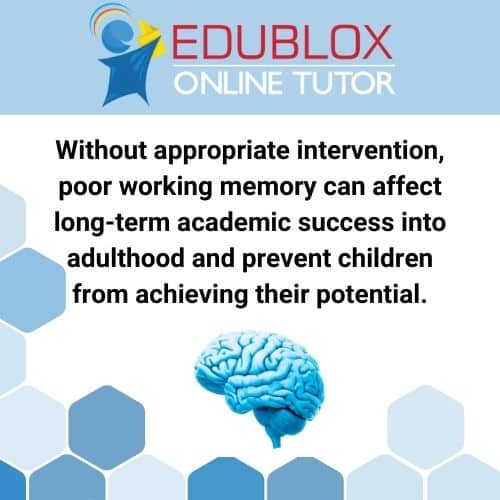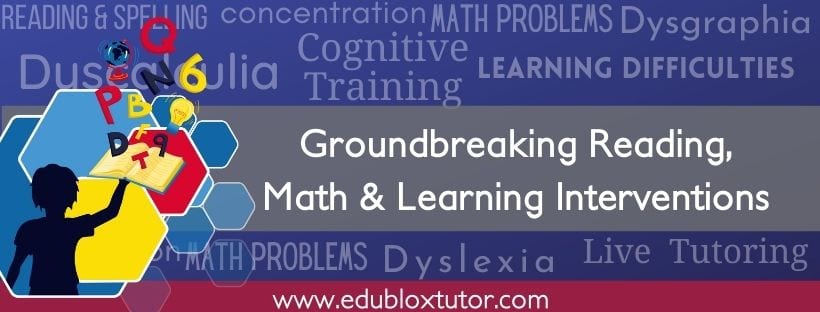
When someone tells us they have a poor memory, they may refer to a range of specific problems. For example, they may need help recalling past events, remembering to do things, or retrieving facts or names.
In everyday life, we talk about memory as a single faculty. However, there are many grounds for thinking that memory is multi-faceted, consisting of several separate but interlinked systems.
Long-term memory is the relatively permanent memory storage system that holds information indefinitely. In it, we store last year’s football scores, the image of an elephant, and how to ride a bicycle. We also appear to be storing information that we can’t consciously retrieve but still affects our behavior.
Short-term memory, on the other hand, refers to our ability to retain temporary information over such intervals, as in looking up a telephone number and then dialing it.
Working memory is a related concept but goes beyond merely retaining information.
Table of contents:
- What is working memory?
- Why working memory matters
- How to improve working memory
- Program to improve working memory
What is working memory?
Working memory is defined as the ability to hold information in your head and manipulate it mentally; it keeps track of transient information and coordinates mental operations in various cognitive tasks.
Dr. Tracy Alloway from Durham University’s School of Education says: “Working memory is a bit like a mental jotting pad, and how good this is in someone will either ease their path to learning or seriously prevent them from learning.”
The classic illustration of working memory in action is complex mental arithmetic, where we typically break the task down into a series of operations. For example, 26 + 37 might be broken down into the stages 20 + 30 = 50 and 6 + 7 = 13 and 50 + 13 = 63 in order to get the answer. To solve an arithmetic problem like (3 X 3) + (4 X 2) in your head, you need to keep the intermediate results in mind (i.e., 3 X 3 = 9) to solve the entire problem.
Other everyday examples of situations placing demands on working memory are talking to a group of unfamiliar people while trying to remember their names or taking notes while following a presentation.

The term ‘working memory’ was coined in 1960 by Miller, Galanter, and Pribram in their classic book Plans and the Structure of Behaviour, used in 1968 by Atkinson and Shiffrin in an influential paper “Human memory: A proposed system and its control processes,” and adopted as the title for a multi-component model by Baddeley and Hitch in 1974.
The distinction between working and short-term memory is an ongoing debate, as the terms are often used interchangeably.
Some scholars insist that some manipulation of remembered information is needed to qualify the task as one of working memory. For example, repeating digits in the same order they were presented would thus be a short-term memory task, while repeating them backward would be a working memory task.
Another viewpoint is that of Nelson Cowan (2001), who says short-term memory refers to the passive storage of information when rehearsal is prevented; storage capacity is around four items. However, when rehearsal is allowed and controlled attention is involved, it is a working memory task, and the capacity is closer to seven items.
Why working memory matters
– It may be a barrier to academic success
According to researchers from Durham University’s School of Education, who produced the world’s first tool to assess memory capacity in the classroom, children who underachieve at school may have poor working memory rather than low intelligence. They surveyed over three thousand schoolchildren and found that ten percent across all age ranges suffer from poor working memory, seriously affecting their learning.
The researchers also found that poor working memory is rarely identified by teachers, who often describe children with this problem as inattentive or as having lower levels of intelligence. Yet, without appropriate intervention, poor working memory can affect long-term academic success into adulthood and prevent children from achieving their potential.
– It may affect attention
Students’ ability to pay attention during class and schoolwork requires processing and retaining information via working memory.
One of the most consistent findings in research studies is that students with ADHD have a poor working memory, particularly when they have to remember visual information, such as graphs or images. In fact, students with ADHD are four times more likely to have working memory problems compared to peers without attention problems.
On the positive side, students with strong working memory are likely to do well maintaining focus and attention in various academic settings. They can more readily be left to work independently because they’re capable of processing and remembering instructions and task goals.
– It may affect reading comprehension
An important and consistent finding is that working memory problems interfere with reading comprehension. Reading is a complex skill that simultaneously activates many different brain processes. For example, when reading a word, the reader must recognize the visual configuration of letters and the letter order and engage in segmentation (breaking the word into individual sounds). Then, while held in working memory, the phonemes (letter sounds) must be synthesized and blended to form recognizable words.
To comprehend sentences, several more skills are necessary. The reader must not only decode the words but also understand the syntax, retain the sequence of words, use contextual cues, and integrate this with existing knowledge. This must be done simultaneously for sentences to be understood. At the same time, sentences must be held in working memory and integrated. Each sentence is read, understood, associated, and integrated with the previous one.

Eventually, the entire paragraph is read, and the reader continues to the next one. By the end of the chapter, the details and main idea need to be retained in working memory. Otherwise, the reader may have retained isolated facts but not know the sequence of events or understand the main idea.
– It matters for math
Mathematics has long been known as a complicated subject, requiring an advanced set of skills. Considerable evidence has appeared in the past two decades concerning the vital role that working memory plays in mathematical cognition. One of the main findings is its role in problem-solving. Cragg et al. (2017) showed that children and adults employ working memory when solving arithmetic problems, no matter what strategy they choose. Their study highlighted the importance of considering working memory in understanding some children and adults’ difficulties with mathematics.
How to improve working memory
Working memory is increasingly recognized as a crucial cognitive skill. By improving this critical skill, one can realize gains in key areas, from school to work to retirement.
The good news is that working memory can be improved with practice, boosting scores in general problem-solving ability and fluid intelligence. Fluid intelligence is the ability to solve new problems, use logic in new situations, and identify patterns. In contrast, crystallized intelligence is the ability to use learned knowledge and experience (Jaeggi et al., 2008).
When doing cognitive skills training, it is essential to note that such training should be multi-cognitive. In physical training, a balanced workout is vital as overtraining one part of the body can cause deformity, such as Popeye syndrome when overtraining the biceps.
The brain is no different. For example, in Maguire et al.’s experiment with London taxi drivers, growth in the posterior hippocampi seems to have come at a cost, as they had reduced anterior hippocampal gray matter volume compared with bus drivers, with anterior volume decreasing with more navigation experience (Maguire et al., 2006).
One should also consider the role of mutualism. A mutualistic view suggests that cognitive abilities mutually facilitate growth. For example, better reasoning skills allow individuals to improve their vocabulary more quickly, and better vocabulary is associated with faster improvement in reasoning ability (Kievit et al., 2017).
Program to improve working memory
The program below aims to improve the working memory of students aged 7 to 70. Below are some guidelines to help you get the maximum benefits from this program:
1. Study the program. The program consists of exercises to improve cognitive skills, including working memory.
2. Start learning the exercises. Once you have studied the program, you should read how to execute the exercises. Do not try to learn all the exercises at once.
Let the learner start with Development Tutor. Study the other two exercises in the program once the learner is comfortable with Development Tutor.
3. Find a quiet time and a quiet place. You will want to find a time that is relatively free from distractions, especially in the beginning, so that the learner can concentrate.
4. Find a suitable time. Early morning is a good time since it helps the learner organize their mind for other intellectual challenges they may face during the day. If the learner goes to school and you can only do the program with them after school, they will need a break before beginning the program.
Depending on your situation, you may break the lesson plan into two short sessions instead of one long session. You could, for example, let the learner do Development Tutor in the morning and the other exercises in the afternoon.
5. Determine how many sessions there should be. You will need to determine how many sessions you will do during the week. The program below is approximately 25-35 minutes in length. Ultimately, one would do five lessons per week, especially if the learner has severe problems with working memory. Four weekly sessions will probably be sufficient if the learner’s problem is not too severe. The basic principle is that the more time you can put into the program, the faster the progress you can expect.
The program
Arrows with a Twist for 3-5 minutes
This exercise consists of six levels and develops various skills such as directionality, sequencing, rapid naming, divided attention, and working memory.
Development Tutor for 15-25 minutes (3 exercises)
Development Tutor aims to improve cognitive skills, including working memory.
Each lesson consists of 3 exercises and takes approximately 20 minutes to complete. Requirements for Development Tutor are Windows (7 or newer) and Mac Computers, using Google Chrome. It is also compatible with Android tablets, minimum screen size: 10″; minimum screen resolution: FHD (1920×1080) or FHD+ (1920×1200).
Parents don’t have to sit with their children while they are doing Development Tutor, but they need to keep an eye to ensure that they are doing the exercises without making notes or using aids to get the answers right. However, when doing the logical thinking exercise, they may use any aids.
In the case of younger learners and those with very slow processing speed, extending the timer is recommended. You can set it back to normal in 2-3 months.
Working Memory Exercise for 4-5 minutes
This exercise consists of two steps. The primary purpose of Step 1 is to improve long-term memory, while Step 2’s objective is to improve working memory.
One must ensure that a student’s working memory deficits have been entirely overcome before discontinuing the program.

